WHAT WE ATE
- Niigata Shoyu Ramen, 80/100 (revisited 16 Oct 2025)
- Rich Dried Sardine Tsukemen, 60/100 (1 Dec 2022)
- Kotteri Se Abura Ramen, 60/100 (9 Jun 2022)
- Maze Soba Aburi Chashu, 60/100 (14 Dec 2023)
- Rich Tori x Nikumori miso ramen, 70/100 (15 May 2021)

Located in the heart of Orchard Road at Paragon, Sanpoutei Ramen has marked its 10th anniversary in Singapore with the launch of its third outlet, echoing its roots in Niigata, Japan, since 1967. Known for its signature Niigata-style shoyu ramen, this brand leans into clear, layered broth—simmered with pork, chicken, vegetables, and Niigata essentials like ago-flying fish and Rishiri kelp—for a subtly complex profile that feels both traditional and fresh.
What sets this Paragon branch apart is the exclusive kombu-bonito tsukemen, a dipping noodle dish that’s drawing steady attention since its May 2025 debut. If you’re hunting for the best ramen in Singapore, especially best shoyu ramen or a standout tonkotsu ramen alternative, this spot near Orchard Road deserves a spot on your radar—before anyone spoils the broth.

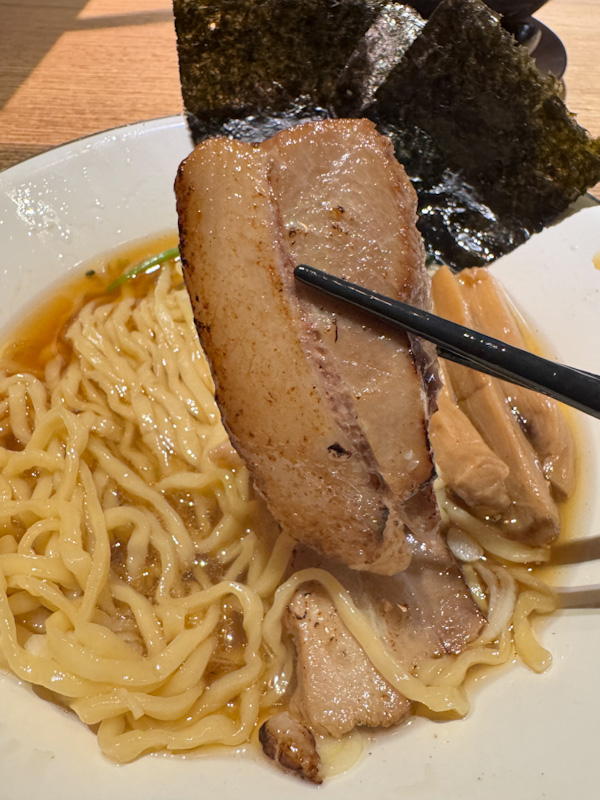
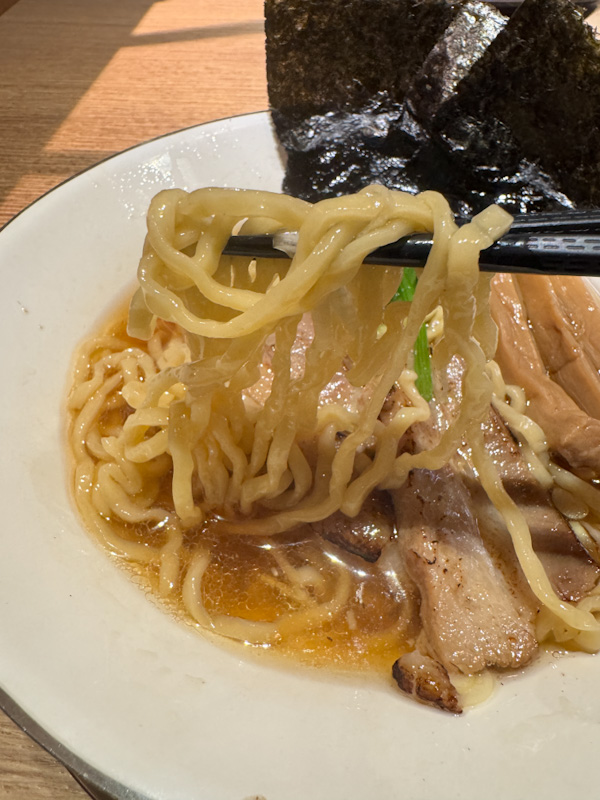

NIIGATA SHOYU RAMEN: 80/100
Noodle: 30/35
The noodles here are thick and slightly flat — an unusual choice that works remarkably well with the Shoyu broth. Their firm texture holds up against the broth’s savoury-sweet balance, offering a bite that’s satisfying without being laborious. Unlike the dense chew of high-hydration mochi-mochi noodles, these sit comfortably in the middle ground: supple, responsive, and clean on the palate. The wheat brings a faint nutty note that rounds out the flavour, with no trace of the acrid alkaline taste that sometimes plagues bright-yellow noodles. It’s a well-calibrated noodle, executed with quiet precision.
Broth: 30/35
This is one of the better Shoyu broths around — rich yet restrained, and unmistakably Niigata in its sensibility. The first sip introduces a deep savouriness that gives way to a clean, balanced body. It’s neither oily nor heavy, instead gliding across the palate with a subtle fragrance of soy that lingers briefly before fading into a refreshingly dry finish. What stands out most is the restraint — the absence of that sharp, bitter tail common in lesser Shoyu broths. The result is a broth that honours tradition while layering just enough depth to feel considered and modern.
Meat: 15/35
The chashu has seen a welcome upgrade since our last visit. Gone are the paper-thin slices — in their place, medium-thick rounds of pork belly with a beautifully caramelised exterior. The fatty sections melt with ease, releasing a buttery richness, while the leaner parts retain a juicy firmness that rewards each bite. The seasoning leans savoury with a measured sweetness, allowing the pork’s natural flavour to shine. A touch of smokiness from the grill ties it all together, adding a dimension that complements the broth’s elegance without overpowering it.
Toppings: 5/10
A minimalist spread, but purposeful.
- The bamboo shoots are handled in the Japanese style — mild, gently sweet, and providing a crisp counterpoint to the soft noodles.
- The negi (spring onions) contribute a piquant freshness that cuts through the broth’s savoury depth. Nothing here is excessive, but it all works in quiet harmony.
Summary
This bowl of Niigata Shoyu Ramen exemplifies balance — neither flashy nor indulgent, but built on restraint and detail. The interplay between firm noodles, clear soy broth, and smoky pork feels thoughtfully tuned. It’s a ramen that doesn’t demand attention, yet rewards those who pay it.

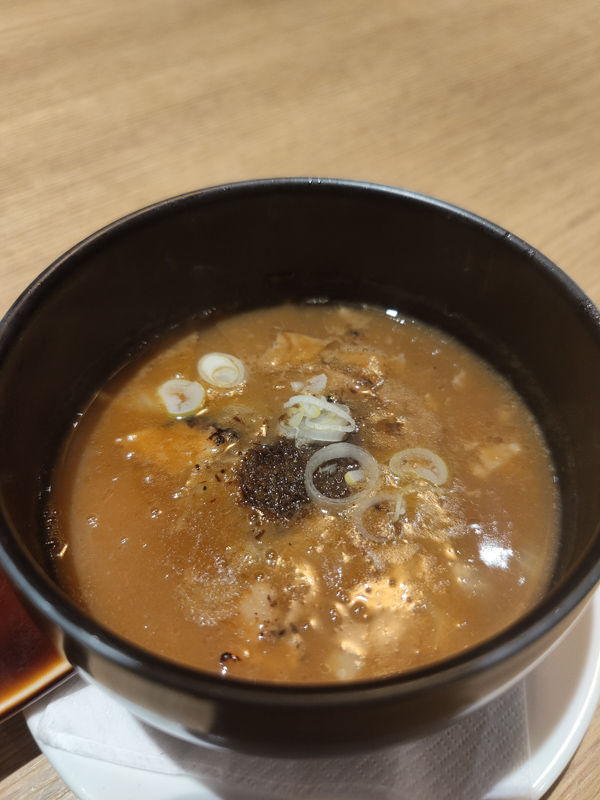
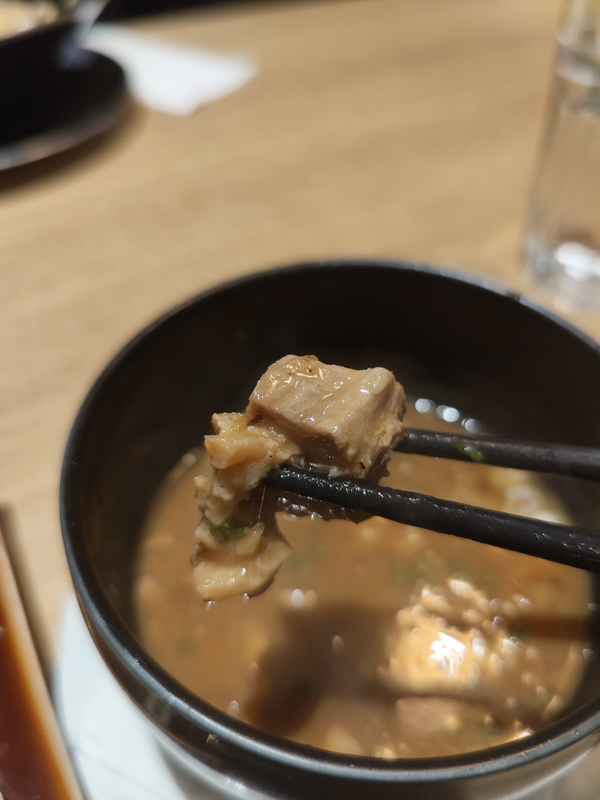
Rich Dried Sardine Tsukemen: 60/100
Noodle: 25/35
The noodles here are thick and flat, designed for a strong pairing with the dense dipping broth. They slurp well and carry the sauce efficiently, but the mouthfeel leans more chewy than springy, which dulls the bite slightly. A touch more elasticity would have elevated the experience. That said, the noodles have a pleasant wheat aroma, adding a subtle fragrance to each bite.
Soup: 25/35
The dipping broth opens with a clear sardine note that asserts itself early on, before giving way to a gently savoury mid-body. Thankfully, it avoids veering into overly fishy territory, which keeps it approachable for most. However, it feels restrained — the depth and punch you’d expect from a sardine-forward tsukemen never quite materialize. It’s competent but lacks that memorable crescendo of flavour.
Meat: 5/20
Instead of the usual chashu slices, the bowl hides small cubes of meat within the dipping broth. While flavour-wise they lean savoury and do release some umami as you chew, the texture is the real letdown. Tough and slightly dry, the cubes become tiresome after a few bites. This is an area that could use significant improvement.
Toppings: 5/10
The marinated egg is the standout here — perfectly executed with a golden, slightly runny center and a mild, savoury-sweet profile that lingers pleasantly. Unfortunately, the rest of the toppings don’t hold up as well. Bamboo shoots are on the tougher side, with a pungency that overshadows rather than complements the broth. Beyond that, the bowl feels sparse, leaving the overall composition underwhelming.
Summary
This tsukemen gets some basics right — like well-paired noodles and a broth that doesn’t overpower — but falters on depth and execution. The sauce lacks punch, the meat feels like an afterthought, and the sparse toppings don’t offer much excitement. At 60/100, it’s a serviceable bowl, but far from one that lingers in memory.
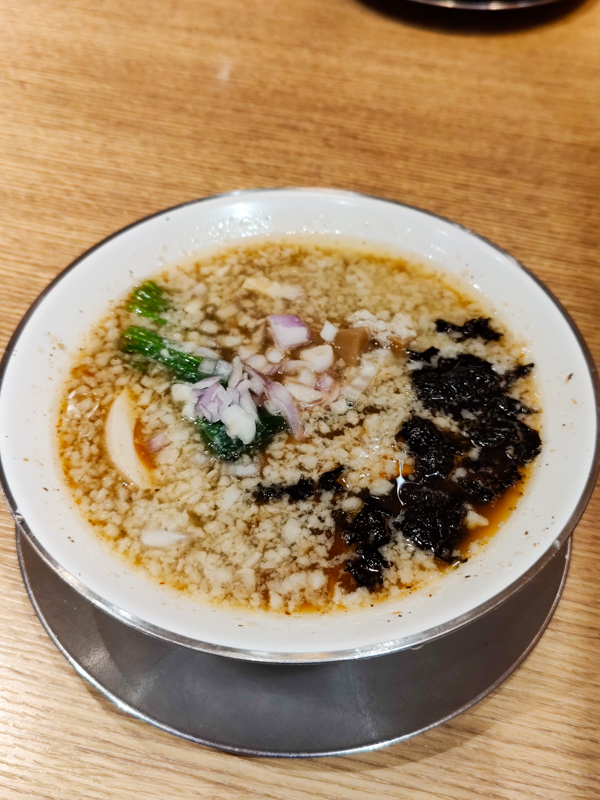
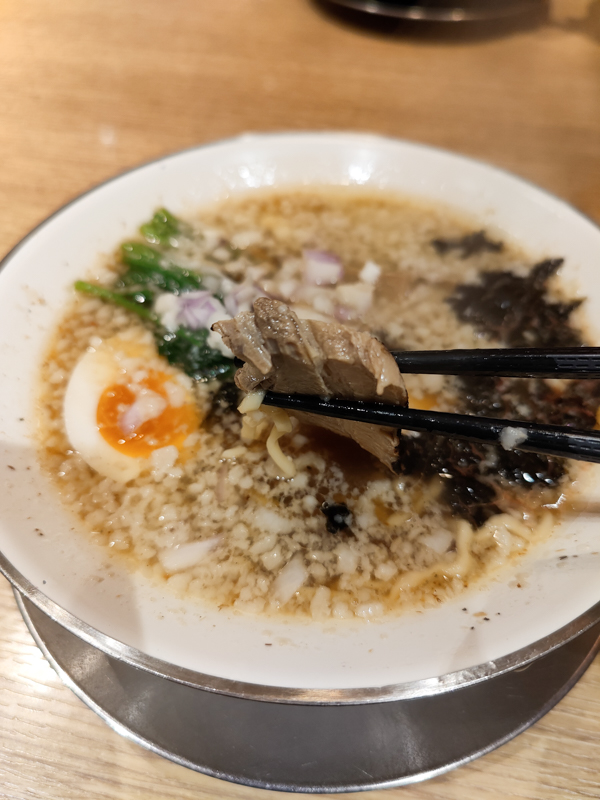

KOTTERI SE ABURA RAMEN: 60/100
To be honest, its not the most pretty looking ramen and a few of you might squirm if I tell you those floaty bits are pork fat. But if you are still with me, you might find this ramen interesting enough.
According to their menu, this ramen originated in Niigata. “It was created for western tableware craftsmen. The very rich yet mild flavor made from dried small sardines soup, thick soy sauce and pork backfat represents the most traditional Niigata Ramen.”
Noodle: 25/35
The noodles are thick and flat, reminiscent of meepok or even linguine. They carry a springy bite with a slight chewiness that works well with the broth. Despite the thicker shape, the flavour of the noodles is surprisingly light, which helps balance the strong sardine base. It’s a good pairing, but the texture could be just a touch more elastic for that ideal slurp.
Soup: 20/35
This sardine-forward broth opens savoury with a faint sweetness in the background, making for a refreshing start. Unfortunately, it doesn’t hold its momentum. As you work through the bowl, the flavour plateaus — the sardine note feels flat and the complexity fades. The floating pork back fat, while visually intriguing, adds little to the taste. It does, however, lend a gelatinous mouthfeel that gives the soup some textural interest.
Meat: 10/20
The chashu in this revisit fares better than before. It’s firm yet tender, breaking apart gently as you bite through. The flavour profile is restrained — less salty than many and without that unpleasant porky tang that sometimes plagues poorly done chashu. While it won’t blow you away, it’s competently executed and complements the bowl well enough.
Toppings: 5/10
- Tamago: Nicely handled, with a golden, watery yolk that’s soft and aromatic.
- Seaweed: A standout for its uniqueness. Unlike the usual nori or wakame, this variety (likely iwanori) is soft, delicate, and carries a pronounced briny sweetness — a thoughtful addition.
- Spicy red onion bits: Add a flicker of sharpness, though they play a minor role.
- Bamboo shoots: The weakest link here — overly pungent and disruptive to the broth’s balance.
Summary
Kotteri Se Abura Ramen is an interesting bowl with roots in Niigata’s ramen tradition, boasting sardine broth and pork back fat as its calling card. While it scores points for uniqueness and textural variety, it struggles to maintain depth through the meal. The soup becomes flat, the toppings uneven, and the overall experience falls short of memorable. At 60/100, this is one for the curious rather than the purist.

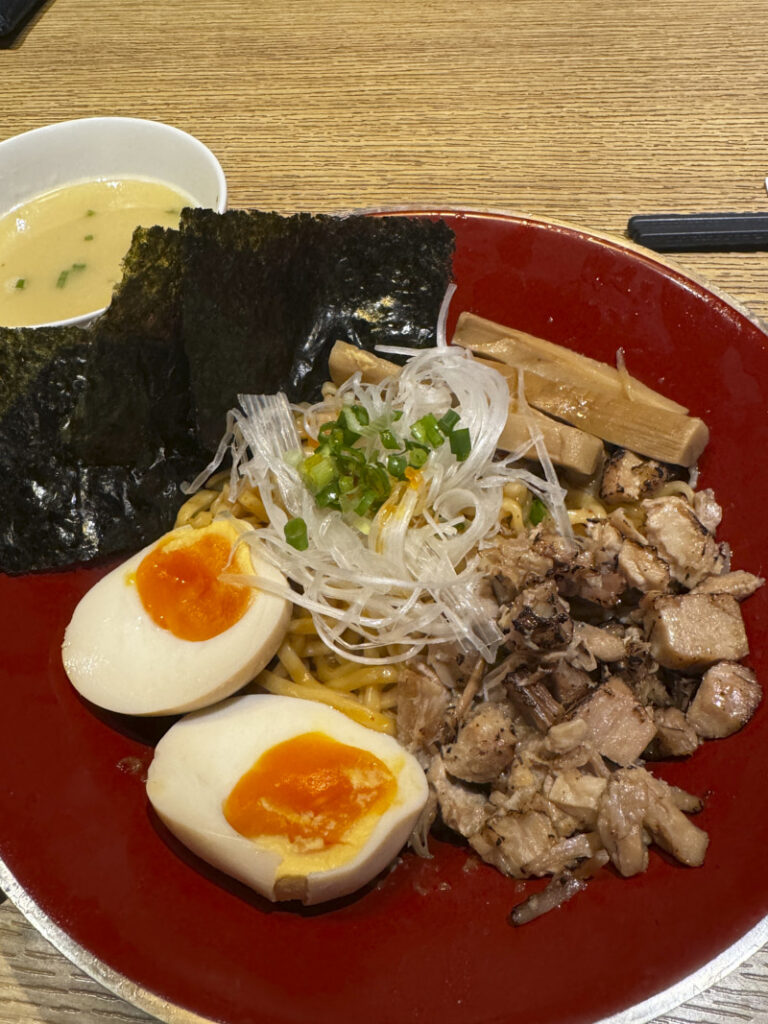

MAZE SOBA ABURI CHASHU “Dried sardine oil x Shoyu”: 60/100
Noodle: 20/35
The noodles are thick and oblong, delivering a satisfyingly springy bite and dense mouthfeel. They do an excellent job holding onto the spicy sauce while carrying a faint smokiness from the aburi chashu. Flavour-wise, there’s a nice wheaty undertone, but it trails off into a lingering kansui aftertaste that feels slightly more pronounced than ideal.
Sauce: 20/35
The sardine oil brings a pleasant aroma and mild umami punch to the mix, setting the stage for the shoyu’s savoury depth. A flicker of spice livens things up, and the saltiness is well-balanced, resulting in a lighter profile compared to richer mazesoba styles. The biggest drawback? The sauce quantity feels insufficient — leaving some noodles undercoated and preventing full flavour integration.
(Note: For those unfamiliar, mazesoba is a brothless ramen variant where toppings and sauce are mixed directly with the noodles. Unlike tsukemen, where noodles are dipped into a separate broth, mazesoba relies entirely on sauce and toppings for flavour.)
Meat: 15/20
The hero element here is the generous heap of aburi-ed chashu cubes. The marination is spot-on — a sweet-savory blend with that irresistible charred aroma. Unfortunately, the texture undercuts the experience. The cubes lean dry and a touch tough, requiring more effort than you’d expect from something flame-seared.
Topping: 5/10
- Negi and Shiranegi: Add a refreshing lift to the bowl but play a minor supporting role.
- Tamago: Nicely marinated, offering a delicate mix of sweet and savoury that softens the otherwise savoury-heavy profile.
Summary
Maze Soba Aburi Chashu leans on aromatic sardine oil and bold shoyu for flavour, but the underwhelming sauce quantity and slightly tough chashu hold it back. It’s a lighter take on mazesoba that some may appreciate, but at 60/100, it feels like a dish that needs fine-tuning to truly shine.
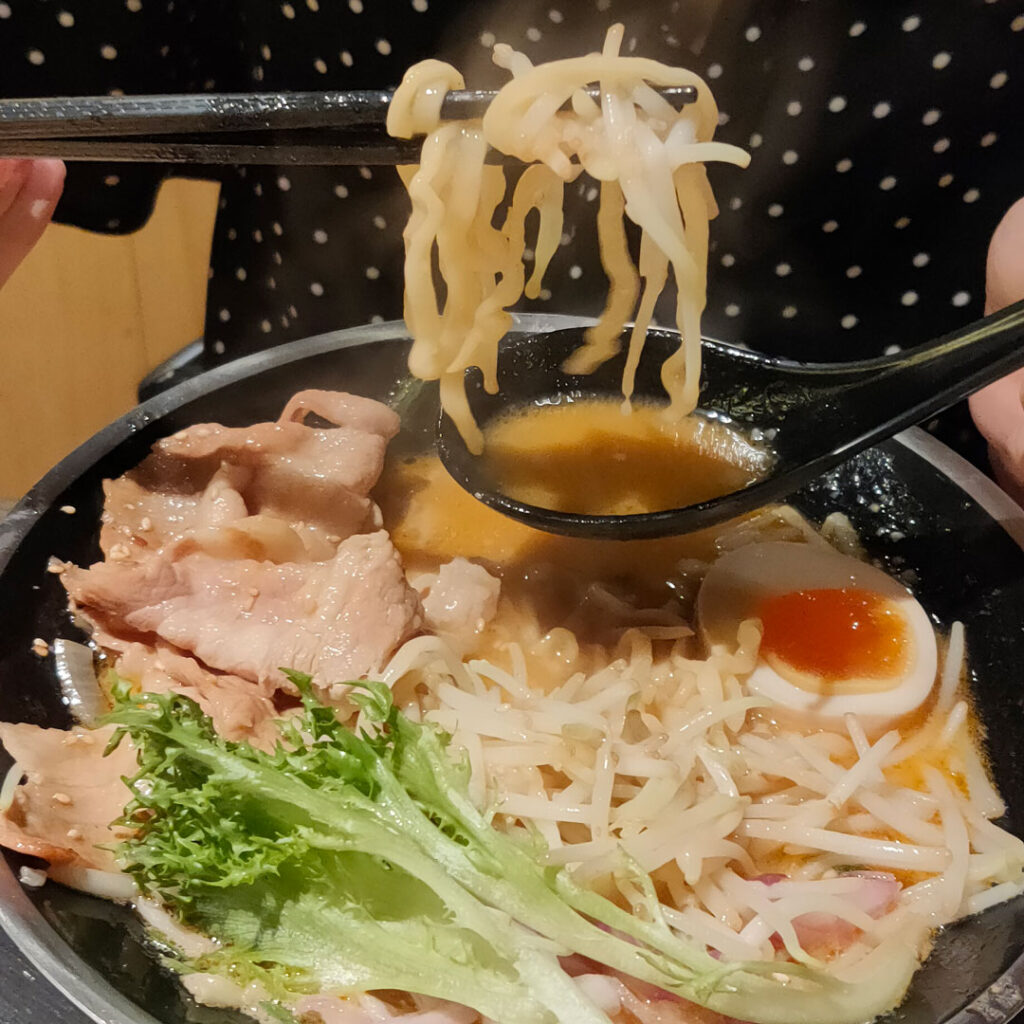
RICH TORI X NIKUMORI MISO RAMEN: 70/100
Noodle: 25/35
The noodles here appear to be a standard across the menu — a thicker style commonly paired with Shoyu ramen. Texture-wise, they deliver a good springy bite without straying into chewiness. What stands out is the absence of that pronounced alkaline aftertaste often associated with thicker noodles (the dreaded “yellow noodle taste”). A solid foundation for the bowl.
Soup: 25/35
Miso ramen isn’t usually my go-to, but this bowl made a decent case for itself. The broth leans rich and slightly viscous, offering a comforting weight on the palate. The incorporation of Tori (chicken) adds an extra layer of umami, rounding off the miso base with a gentle savoury sweetness. It’s a satisfying broth that avoids being overly salty, though it doesn’t quite push into the realm of exceptional.
Meat: 10/20
The chashu is thinly sliced and texturally fine — soft enough to mingle well with the noodles. That said, it’s forgettable in flavour, lacking the depth or marbling that would make it crave-worthy. It does its job, but it’s not a highlight.
Toppings: 10/10
- Tamago: Nicely executed with a golden, semi-runny yolk and a subtle, pleasant aftertaste from the marinade.
- Beansprouts & leafy greens: Generous portions that act as excellent palate cleansers between bites, keeping the heaviness of the miso broth in check.
Summary
Rich Tori × Nikumori Miso Ramen is a comforting bowl with its thicker noodles and umami-laden broth, elevated by a touch of chicken richness. While the chashu doesn’t impress, the thoughtful toppings and balance in the soup make this a respectable option for those who enjoy a heartier miso profile. At 70/100, it’s a solid middle ground for miso lovers without being overly indulgent.
DISCLAIMER
One man’s meat is another man’s poison.
Find out more about our palettes and how we evaluate our ramen here. 😉

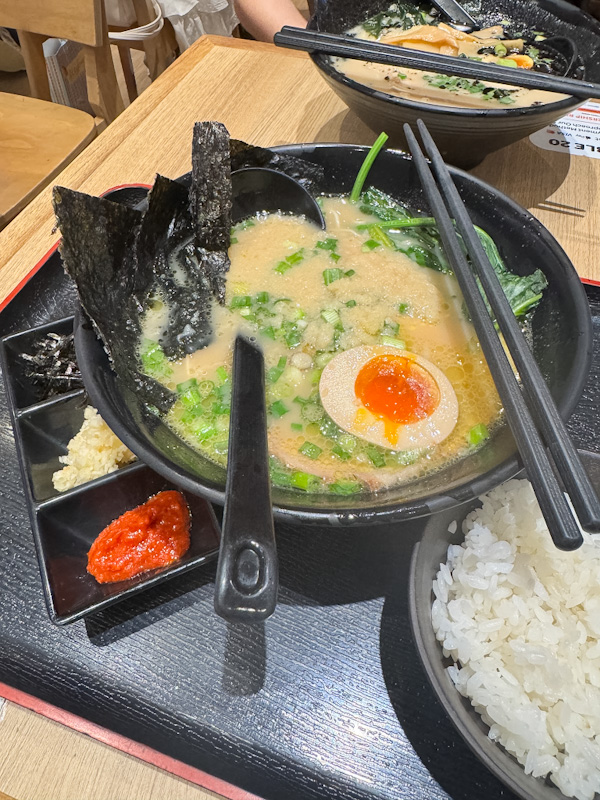
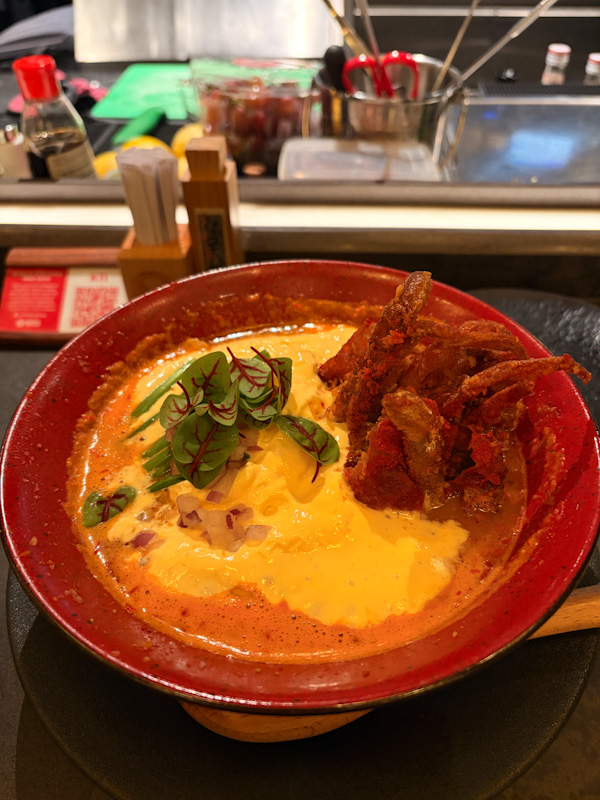
Pingback: Review of Ippudo Singapore